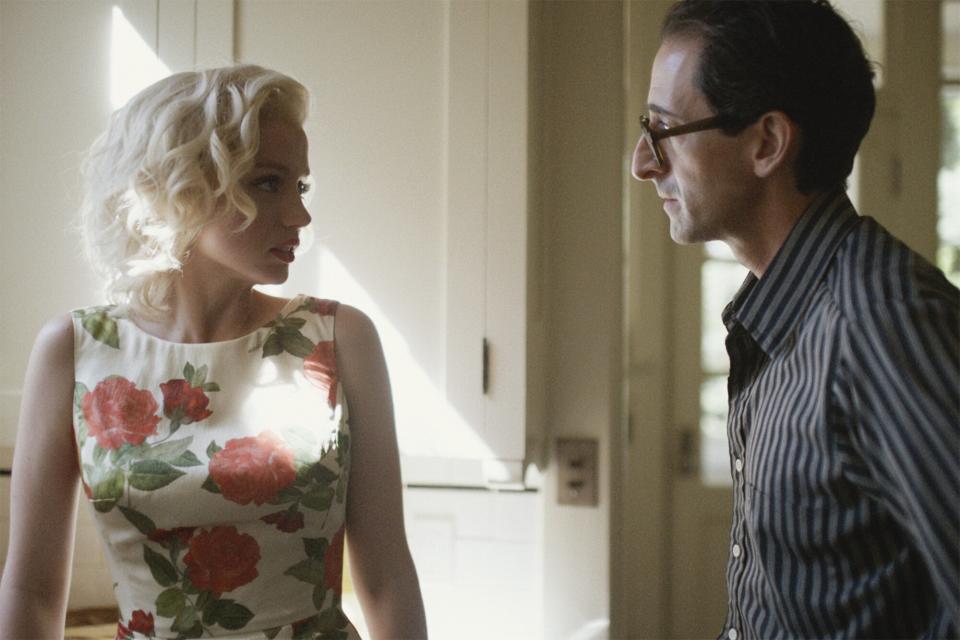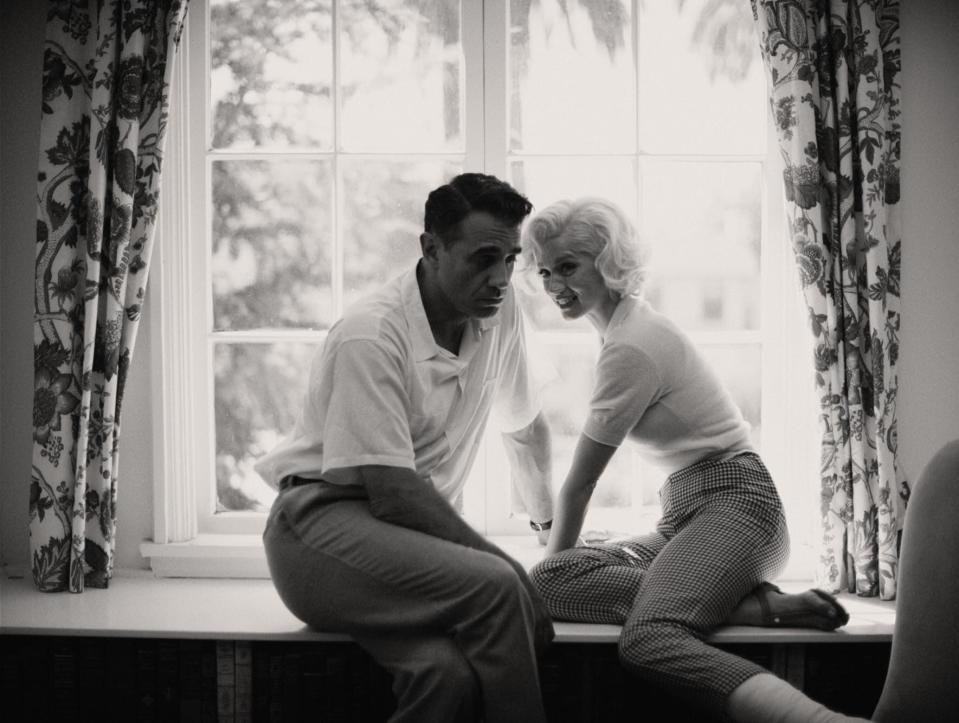Fact or fiction: 6 scenes from Blonde and the real-life stories behind them

- Oops!Something went wrong.Please try again later.
Both in life and death, Marilyn Monroe has been mired in conspiracies. The new film Blonde, now on Netflix and based on Joyce Carol Oates' unconventional novel, trades heavily in the imagined details of Monroe's life rather than cold hard facts.

Everett Collection; Netflix
Blonde's writer-director Andrew Dominik is less interested in a straightforward presentation of Monroe (Ana de Armas), instead aiming for an expressionistic, often brutal tone poem that uses exploitation as its medium of choice.
Regardless, any movie that takes a real-life figure as its subject must grapple with what is truth and what is invention. Here, we round up some of the most jarring suppositions in Blonde to tease out whether they are fact or fiction.
Did Marilyn's mother really attempt to drown her?
In many ways, Blonde is a collection of Monroe's assorted traumas, beginning with her abusive childhood at the hands of a mentally ill mother, Gladys (Julianne Nicholson). One particularly harrowing scene shows Gladys filling a bathtub with scalding hot water and holding the young Marilyn under the water in an attempt to drown her. No records indicate this actually happened. It may be a moment devised for dramatic impact. However, despite no evidence of an attempted drowning, Monroe did speak privately of incidents of abuse. "Her mother tried to kill her three times," Monroe's third husband Arthur Miller told the BBC in 1968. "Throughout most of her life, Marilyn often remarked how she could still vividly recall these horrific encounters."
Was Marilyn in a throuple with the sons of Charlie Chaplin and Edward G. Robinson?

Matt Kennedy / Netflix 'Blonde' charts Marilyn Monroe's life as a violent fever dream.
One of the more salacious plot points of Blonde is Monroe's relationship with two men also haunted by the specter of fame: Charles "Cass" Chaplin Jr. (Xavier Samuel) and Edward G. Robinson Jr. (Evan Williams). In the film, she meets them at an acting class in L.A., and the two men are already an item, inviting Norma Jeane into their sexual relationship. It forms a bond that ultimately lasts throughout her life.
In reality, there is not a shred of evidence to indicate Monroe was ever in a throuple, nor that Robinson and Chaplin were gay, bisexual, or in a relationship with each other. Monroe did reportedly date Chaplin for a time, even meeting his famous father at a lunch, according to his memoir My Father. If Monroe ever knew Robinson at all (he had a small role in Some Like It Hot), they were nothing more than acquaintances. As for the film's speculation that Cass's death played a role in Marilyn's own tragic end, he died six years after she did, so nope.
Was Marilyn forced to have an abortion by the studio?
Dominik's rendering of Monroe's forced abortion, including a talking fetus and a shot from inside her vagina, is shocking — but whether this was a real event in her life (minus the talking fetus, of course) remains a gray area. There's no concrete evidence Monroe ever had an abortion, and it's not something she ever admitted or discussed.
However, it was a common practice at the time for Hollywood actresses to either choose abortions for the sake of their careers or be encouraged to get them by their studios. Indeed, actresses were known to take a "rest" or be out for an "appendectomy" while the studio arranged for them to terminate a pregnancy. Ava Gardner, for one, had a clause in her contract which said that having a baby would result in her salary being cut off. Others, like Bette Davis, simply chose their work over starting a family. And there were, of course, stars pressured into abortions by studio moguls, most notably Judy Garland. But whether or not Monroe was one of them remains a mystery.
What about the miscarriage?

Netflix
Monroe's miscarriage while married to playwright Arthur Miller (Adrien Brody) is factually accurate (though the technical cause, her tripping on the beach, seems to be invented). Monroe first had a miscarriage in 1956, then an ectopic pregnancy in 1957, and a third miscarriage in 1958. Though the particulars are not known, her miscarriages were clearly a source of stress in their marriage. Other factors that contributed to tensions between them included Miller's betrayal of trust by using her words in his plays, and his creating a thinly veiled version of Monroe for 1964's After the Fall.
Was Joe DiMaggio enraged by the subway-grate scene in The Seven Year Itch?

Netflix Bobby Cannavale and Ana de Armas in 'Blonde'
Monroe's marriage to baseball legend Joe DiMaggio is a brief part of the film, with Bobby Cannavale playing DiMaggio. It was a tempestuous union of only nine months, with numerous accounts of DiMaggio's physical abuse of Monroe, largely prompted by his jealousy and insecurity over her bombshell image and her fame. After the filming of the subway-grate scene in The Seven Year Itch (a publicity stunt), DiMaggio reportedly beat up Marilyn in their hotel room later that night. DiMaggio's son also recalled his father's physical attacks on Monroe, remembering waking up to "the sound of my father and Marilyn screaming. … After a few minutes, I heard Marilyn race down the stairs and out the front door, and my father running after her. He caught up to her and grabbed her by the hair and sort of half-dragged her back to the house. She was trying to fight him off but couldn't."
What about that casting couch?
Early in the film, Norma Jeane takes a meeting with Mr. Z, presumably Darryl F. Zanuck, the head of Twentieth Century-Fox. She is hoping to land a role or a contract from their meeting, and she does, but only after he rapes her.
While the sexual abuses by studio moguls and executives during the Golden Age of Hollywood are well-documented, there is no proof that Zanuck assaulted Monroe. Zanuck was known for his questionable meetings with starlets and a predilection for flashing women with his penis. But Monroe seems to have escaped unscathed (though she was, of course, exploited on screen and molested as a teenager in foster homes). "In interviews with almost 700 people, I encountered nothing to suggest that any Hollywood producer raped Monroe," said biographer Anthony Summers in The Guardian.
In fact, Monroe squared off against Zanuck and won (a show of agency and empowerment Blonde neglects to include): Fed up with terrible scripts and bimbo roles, Monroe sent a screenplay back to Zanuck's office with the word "trash" scrawled across it, before breaking her contract and escaping to New York. Once there, she founded her own production company, spurring a legal battle with Fox, which resulted in her salary being increased and her getting approval over the writer, director, and cinematographer on all of her projects.
Related content:

